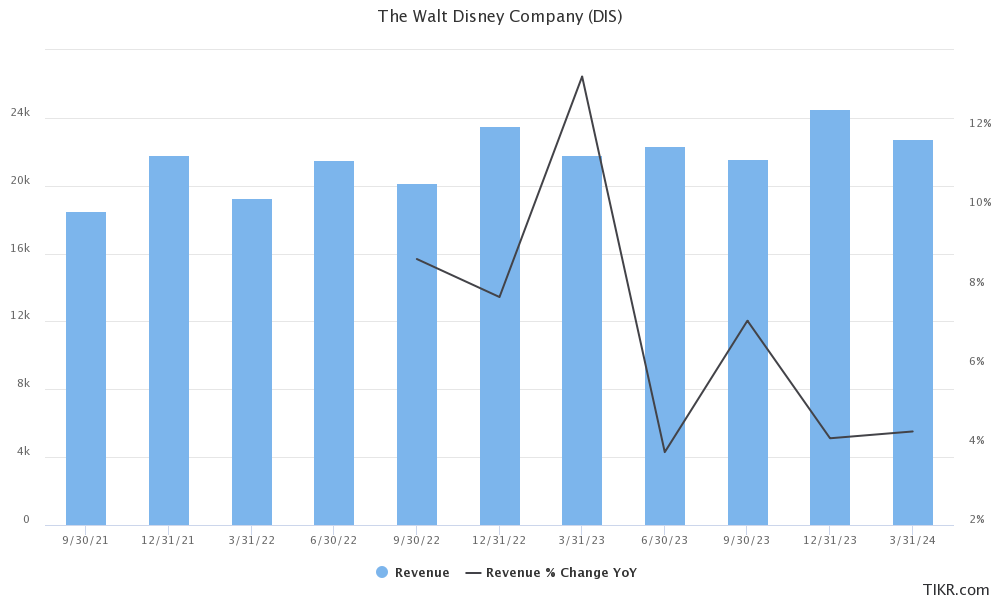Disney Stock Whipsaws After Q3 Earnings: Key Takeaways
Please note that we are not authorised to provide any investment advice. The content on this page is for information purposes only.
Disney (NYSE: DIS) released its fiscal Q3 2023 earnings yesterday after the markets closed. The stock whipsawed after reporting mixed results and while it fell after the release it rose almost 5% after the earnings call. It is up only about 1% in premarkets though. Here are the key takeaways from the entertainment giant’s earnings.
Disney reported revenues of $22.33 billion in the three-month period that ended on July 1, which was 4% higher YoY and trailed analysts’ estimates of $22.5 billion. The company’s adjusted EPS came in at $1.03 versus the 95 cents that analysts expected. However, it reported a net loss of $460 million in the quarter due to a $2.65 billion impairment charge.
Disney stock whipsaws on mixed results
In his prepared remarks, Disney’s CEO Bob Iger said, “Our results this quarter are reflective of what we’ve accomplished through the unprecedented transformation we’re undertaking at Disney to restructure the company, improve efficiencies, and restore creativity to the center of our business.”
He added, “In the eight months since my return, these important changes are creating a more cost-effective, coordinated, and streamlined approach to our operations that has put us on track to exceed our initial goal of $5.5 billion in savings as well as improved our direct-to-consumer operating income by roughly $1 billion in just three quarters.”
Streaming losses fall but subscriber count misses estimate
Ever since he took over, Iger has been trying to cut down the streaming losses and the strategy has worked well. The segment posted a net loss of $512 million in the fiscal third quarter which is around half of the $1.1 billion that it posted in the corresponding quarter last year and nearly a third of the $1.47 billion that it peaked at in the fiscal third quarter of 2022.
Meanwhile, while the segment’s losses continue to narrow, its subscriber count has also fallen for two quarters, and in fiscal Q3 it fell 7.4% to 146.1 million which was below what analysts expected. Netflix on the other hand added 5.9 million subscribers in the June quarter which was ahead of estimates.
Most of the subscriber loss was in India where the company offers the lower-priced Disney+ Hotstar. The subscriber count in the region fell 24% as compared to the previous quarter even as the subscribers in US and Canada fell only about 1%.
Disney raises subscription prices
In order to further boost the streaming segment and hit the goal of breakeven by the next fiscal year, Disney also raised the price of its ad-free tiers and said that it would raise the prices of ad-supported tier in October.
Like rival Netflix, Disney would also start cracking down on password sharing but while Netflix said that it estimates 100 million people watch its content through shared passwords, Disney did not provide a number but Iger said that “it’s significant.”
He also refrained from speculating about the company’s ability to convert those who watch its content through shared passwords into subscribers. Iger said, “Obviously, we believe there will be some, but we’re not speculating.”
He added that the company would work on password sharing in the next fiscal year and added, “we certainly have established this as a real priority. And we actually think that there’s an opportunity here to help us grow our business.”
DIS is looking at strategic options for its linear TV business
Iger has talked about the disposal of linear TV assets as an option previously also. During the earnings call, Iger said, “While linear remains highly profitable for Disney today, the trends being fueled by cord-cutting are unmistakable. And as I’ve stated before, we are thinking expansively and considering a variety of strategic options.”
Iger, who is working on a turnaround strategy for Disney spelled out the strategic priorities and said, “Moving forward, I believe three businesses will drive the greatest growth and value creation over the next five years. They are our film studios, our parks business, and streaming, all of which are inextricably linked to our brands and franchises.”
The company is also considering a full buyout of Hulu which is partially owned by Comcast and the deal might cost Disney around $9 billion.
ESPN enters sports betting
Meanwhile, Disney has partnered with Penn Entertainment to launch ESPN Bet which marks the company’s entry into the sports betting industry. Iger said that Disney discussed getting into the betting industry with multiple entities but eventually choose Penn as it “stepped up in a very aggressive way and made an offer to us that was better than any of the competitive offers by far. And we like the fact that PENN is going to use this as a growth engine for their business.”
The company added that ESPN would make the transition to the direct-to-consumer business and it was a question of “when” and not “if.” Iger said, “The team is hard at work looking at all components of this decision, including pricing and timing.
Some recent Disney releases have disappointed
Some of the recent Disney releases like Pixar’s “Elemental” and “Indiana Jones and the Dial of Destiny” had disappointing box office collections.
Alluding to these failures, Iger said, “the performance of some of our recent films has definitely been disappointing, and we don’t take that lightly.”
He added, “And as you’d expect, we’re very focused on improving the quality and the performance of the films that we’ve got coming up. It’s something that I’m working closely with the studio on. I’m personally committed to spending more time and attention on that as well.”
Meanwhile, despite the euphoria over Iger’s return to Disney, the stock has sagged and is below the levels which he took over – underperforming the markets by a wide margin.






